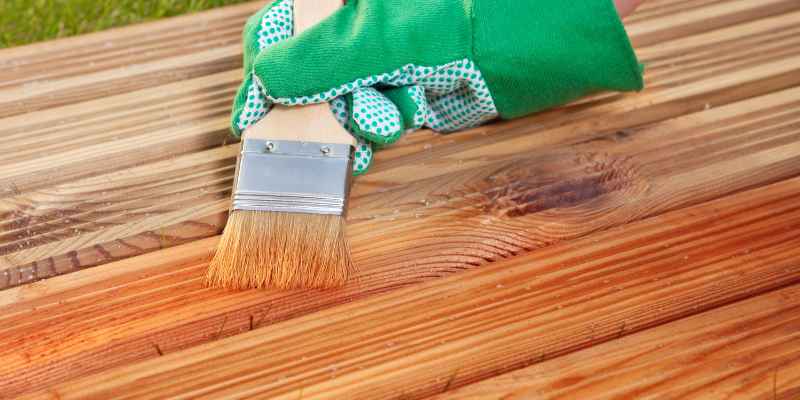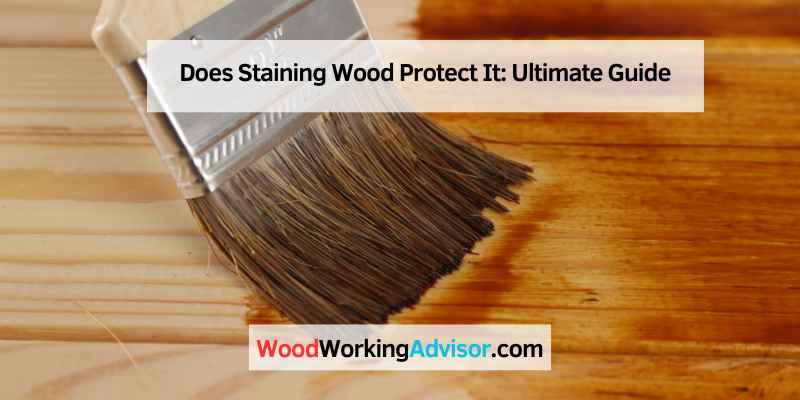Staining wood does protect it by sealing off the pores, preventing water absorption, and adding a layer of protection against UV rays. This treatment not only enhances the wood’s color but also minimizes or prevents discoloration from the sun.
Additionally, staining can help prolong the wood’s lifespan by preventing rot and decay. Using a high-quality exterior stain is recommended for optimal protection.
Difference Between Wood Stain And Wood Finish
Staining wood not only adds color but also creates a protective barrier by sealing off the pores, preventing water absorption and minimizing discoloration caused by UV rays. It’s an effective way to enhance the appearance of wood while providing a layer of defense against environmental elements.
Understanding Wood Stain
Wood stain is a type of finish that is specifically designed to add color to wood surfaces while allowing the natural grain to show through. Unlike paint, which sits on top of the wood surface, wood stain penetrates the pores of the wood, enhancing its natural beauty. Stains are available in a wide range of colors, from light to dark shades, allowing you to choose the perfect hue to complement your desired aesthetic.
Understanding Wood Finish
Wood finish, on the other hand, is a protective coating that is applied to the surface of the wood to provide durability and protection against moisture, UV rays, and general wear and tear. It forms a protective barrier that seals the wood, preventing moisture from penetrating and causing damage such as warping or rotting. Wood finishes are available in different forms, such as varnish, polyurethane, lacquer, or shellac, each with its own unique properties and application methods.
While wood stain and wood finish are often used interchangeably, they serve different purposes in preserving and enhancing wood surfaces.
– Wood stain primarily focuses on adding color, enhancing the natural beauty of the wood, while wood finish primarily focuses on protecting the wood from external elements.
– Stain penetrates the wood, while finish sits on top of the surface.
– Stain enhances the grain and texture of the wood, while finish provides a smooth and glossy protective layer.
– Stain is available in a wide range of colors, while finish is typically transparent or clear.
– Stain is usually applied before the finish, as it needs to penetrate the wood surface, while finish is applied as the final layer to protect the stained wood.
Overall, both wood stain and wood finish play important roles in preserving and enhancing the appearance of wood surfaces. It is common to use both products together, applying the stain first to achieve the desired color, and then applying the finish to provide protection and durability.
In conclusion, understanding the difference between wood stain and wood finish is crucial when it comes to protecting and enhancing wood surfaces. While stain provides color and highlights the natural beauty of the wood, finish acts as a protective layer, shielding the wood from moisture, UV rays, and general wear and tear. By utilizing both products, you can ensure that your stained wood surfaces not only look stunning but also stand the test of time.
Applying Wood Stain
Staining wood does offer protection by sealing its pores against moisture, as well as providing a barrier against the sun’s UV rays, effectively preventing discoloration. Additionally, high-quality exterior stains with active ingredients can help prolong wood decay, making staining a practical and aesthetically pleasing choice for wood protection and enhancement.
Preparation And Application
Proper preparation of the wood surface is essential before applying stain. Ensure the wood is clean, dry, and free of any existing finish.
Effects On Wood Condition
Applying wood stain not only adds color but also provides protection by sealing off the pores in the wood. This helps prevent water intrusion and minimizes discoloration due to UV rays.
Applying Multiple Coats
When applying multiple coats of wood stain, allow each coat to dry completely before adding another layer. This ensures an even and long-lasting finish.
Common Mistakes In Wood Staining

When staining wood, many people wrongly assume that it automatically protects the wood. However, while staining does add color and enhance the appearance, it alone doesn’t provide full protection. To truly protect wood from water, UV rays, and decay, it’s essential to apply a waterproof wood sealant after staining.
Enhance the appearance and extend the life of your wood projects by ensuring proper protection with both staining and sealing.
Staining doesn’t just color wood but also provides protection by sealing off pores and shielding from UV rays.
Over-staining
Applying excessive stain can lead to an unnatural appearance and may not enhance protection.
Issues With Different Types Of Finish
Choosing the wrong finish can impact the stain’s effectiveness and the wood’s overall durability.
Does Wood Stain Provide Protection?
Staining wood not only adds color but also provides protection by sealing off the pores, preventing water absorption and minimizing discoloration. It also offers defense against the damaging effects of UV rays from the sun. Applying a stain is a simple and effective way to enhance the appearance and durability of wood surfaces.
Sealing Wood After Staining
After staining wood, it is important to seal it to provide an extra layer of protection. Sealing the wood helps to lock in the stain and prevents it from fading or wearing off over time. It also helps to protect the wood from moisture, UV rays, and other elements that can cause damage.
Waterproofing Effect Of Wood Stain
Wood stain can have a waterproofing effect, but it is not completely waterproof on its own. Stains are typically used to enhance the color of the wood and make it more weather-resistant. However, they do not stop water movement through the wood entirely.
There are two basic product categories for waterproofing: stains and sealants. Stains are used on wood to enhance color and make them weather resistant. Sealants, on the other hand, are specifically designed to protect concrete and wood from moisture. While stains can offer some level of protection against water, using a sealant in addition to the stain will provide better waterproofing.
When applying a sealant, it is important to choose the right product for the type of wood and the intended use. There are various options available, including clear sealers and waterproof coatings. These sealants create a barrier that prevents water from penetrating the wood, keeping it safe from rot, mold, and other forms of damage.
Overall, while staining wood can provide some protection against moisture and UV rays, it is recommended to seal the wood after staining for better waterproofing and extended durability.
Protecting Wood From Decay
Wood is a versatile and durable material that can be used for a variety of purposes, including furniture, flooring, and outdoor structures. However, one of the biggest threats to wood is decay caused by exposure to the elements. Protecting wood from decay is essential to ensure its longevity and maintain its aesthetic appeal. In this blog post, we will explore the role of staining in protecting wood from decay and the methods to prevent wood decay effectively.
Preventing Wood Decay
Wood decay can be caused by various factors, including moisture, fungi, insects, and UV radiation. To prevent wood decay, it is crucial to take proactive measures to protect the wood from these elements.
Role Of Exterior Staining
Exterior staining plays a vital role in protecting wood from decay. Stains are specifically formulated to penetrate the wood surface, creating a protective barrier against moisture, UV rays, and other external threats. Furthermore, wood stains contain active ingredients that inhibit the growth of fungi and deter insects, thus prolonging the wood’s lifespan.
Understanding The Additives In Wood Stains
Role Of Additives In Protection
Wood stains serve not only to enhance the aesthetic appeal of wood but also to safeguard it from various environmental factors. The protective attributes of wood stains are made possible by the inclusion of additives that contribute to the overall durability and resilience of the stained wood. These additives play a crucial role in determining the effectiveness of the stain in protecting the wood against moisture, UV rays, and other damaging elements.
Ensuring Maximum Durability
By incorporating additives such as UV blockers, mildewcides, and water repellents, wood stains can significantly enhance the long-term protection of wood surfaces. The UV blockers help prevent discoloration and deterioration caused by sunlight exposure, while mildewcides inhibit the growth of mold and mildew, thereby preserving the integrity of the wood. Moreover, water repellents aid in preventing water penetration and subsequent damage to the wood, ensuring its longevity.
Comparison Of Stain And Oil For Wood Protection
Wood Stain vs. Wood Oil: When considering wood protection, an essential aspect to weigh is the choice between using a wood stain or wood oil. Both methods offer distinctive benefits in safeguarding wood from moisture, rot, and other external factors.
Waterproofing Properties Of Stain
Enhancing Weather Resistance: Stains are designed to not only enrich the natural color of the wood but also provide a protective barrier that repels water and prevents moisture infiltration.
Effectiveness Against Moisture And Rot
Preventing Wood Decay: Applying a quality exterior stain can significantly reduce the risk of wood decay by incorporating active ingredients that shield the wood from environmental elements.
Prolonging Wood Durability: By penetrating the wood fibers, stains help fortify the structure and enhance its longevity, thereby inhibiting rot and decay.
Improving Finish Quality: Many wood stains include additives that simplify the application process while elevating the overall appearance of the wood surface.

Frequently Asked Questions On Does Staining Wood Protect It
Does Stain Actually Protect Wood?
Staining adds color and protects wood by sealing off pores, preventing water absorption and UV damage.
Do I Need To Seal Wood After Staining?
Staining seals wood, preventing water absorption and adds UV protection. It’s advisable to seal wood after staining for complete protection.
Does Wood Stain Make Wood Waterproof?
Wood stain does provide some protection against water by sealing off the pores in wood. It also adds a layer of protection from UV rays, minimizing discoloration. However, it is not completely waterproof and may not withstand prolonged exposure to water.
Will Stain Keep Wood From Rotting?
Yes, applying a high-quality exterior stain can prevent wood from rotting by protecting it from common elements and adding a layer of protection. Staining seals off the wood pores, preventing water absorption and minimizing or preventing discoloration from UV rays.
Conclusion
Staining wood not only adds color and enhances the natural grain, but it also serves as a protective layer. By sealing off the pores in the wood, staining prevents water absorption and minimizes or prevents discoloration caused by the sun’s UV rays.
While some stains may have additives that offer a small degree of protection, it is generally recommended to apply a high-quality exterior stain for optimal wood preservation and decay prevention. Overall, staining wood is a simple and effective way to protect and enhance the appearance of wood surfaces.


